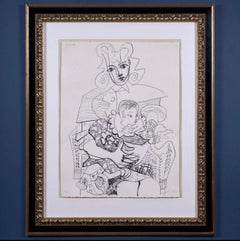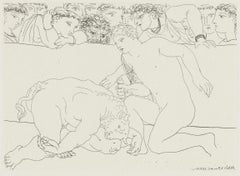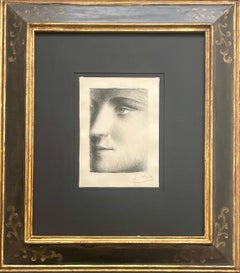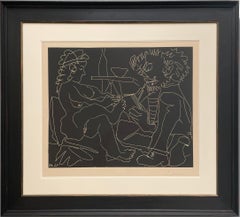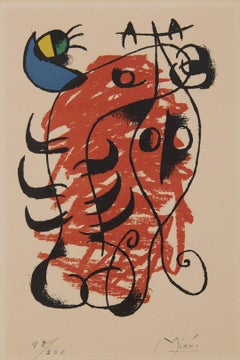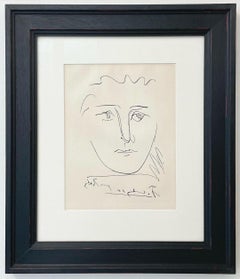Pablo Picasso Art
One of the most prolific and revolutionary artists the world has ever seen, Pablo Picasso had a tremendous impact on the development of 20th-century modern art. Although he is best known for his association with the Cubist movement, which he founded with Georges Braque, Picasso’s influence extends to Surrealism, neoclassicism and Expressionism.
“Every act of creation is, first of all, an act of destruction,” the Spanish artist proclaimed. In Picasso's Cubist paintings, he emphasizes the two-dimensionality of the canvas, breaking with conventions regarding perspective, foreshortening and proportion. Picasso was inspired by Iberian and African tribal art. One of his most famous pre-Cubist works is Les Demoiselles d’Avignon (1907), a painting considered immoral and shocking at the time for its depiction of nude women whose faces resemble Iberian tribal masks.
Picasso made many portraits in this style, most often of the women in his life, their expressively colored faces composed of geometric shards of surface planes. In Woman in a Hat (Olga), 1935, he painted his first wife as an assemblage of abstract forms, leaving the viewer to decipher the subject through the contrasting colors and shapes. Picasso was a tireless artist, creating more than 20,000 paintings, drawings, prints, ceramics and sculptures. Tracing his life’s work reveals the progression of modern art, on which he had an unparalleled influence.
Browse an expansive collection of Pablo Picasso's art on 1stDibs.
1940s Pablo Picasso Art
Lithograph
1930s Pablo Picasso Art
Etching
1920s Pablo Picasso Art
Lithograph
1960s Pablo Picasso Art
Linocut
1950s Abstract Pablo Picasso Art
Lithograph
1980s Pablo Picasso Art
Lithograph
Early 20th Century Art Deco Pablo Picasso Art
Etching
1970s Modern Pablo Picasso Art
Lithograph
1970s Modern Pablo Picasso Art
Lithograph, Stencil
Early 20th Century Expressionist Pablo Picasso Art
Etching
Late 19th Century French School Pablo Picasso Art
Lithograph
1970s Color-Field Pablo Picasso Art
Etching, Pencil, Monoprint
20th Century Expressionist Pablo Picasso Art
Etching
Early 20th Century Expressionist Pablo Picasso Art
Etching
2010s Contemporary Pablo Picasso Art
Paper, Linocut
Mid-20th Century American Modern Pablo Picasso Art
Linocut
Mid-20th Century Pablo Picasso Art
Etching
Pablo Picasso art for sale on 1stDibs.
Artists Similar to Pablo Picasso
- 1stDibs ExpertOctober 7, 2024To tell if a Picasso sketch is real, first compare the signature on your piece to images of authentic works shared by trusted online resources. Looking for any anomalies and learning about the various materials and techniques that the Spanish artist employed during the different phases of his career can also be helpful. If you know approximately when your sketch was likely produced, you can determine whether the materials and techniques are appropriate for that period. Because there are so many Picasso counterfeits on the market, you may wish to have a certified appraiser or knowledgeable art dealer perform a professional authentication. Find a collection of Pablo Picasso art on 1stDibs.
- 1stDibs ExpertOctober 7, 2024The difference between Matisse and Picasso is that their work is associated with different art movements. Henri Matisse was a leading proponent of Fauvism, a movement whose name is derived from the French word for "wild beast.” Marked by vibrant hues, Fauvist paintings like Matisse’s famous 1906 composition Le Bonheur de vivre have wild, active brushstrokes and a palette unconstrained by nature, resulting in imagery like women with purple skin and trees with orange leaves. Although his work evolved over the course of his career, Pablo Picasso is best known for his association with the Cubist movement, which he is credited with founding with Georges Braque. In Cubist works, reality gets fragmented into flat, geometric forms. Shop a collection of Henri Matisse and Pablo Picasso art on 1stDibs.
- Are Picasso drawings valuable?1 Answer1stDibs ExpertMay 14, 2024Yes, some Picasso drawings are valuable. In terms of auction sales, Picasso is the top-grossing artist of all time. However, his paintings often sell for considerably more than his drawings, largely due to the fact that the prolific artist produced tens of thousands of sketches during his life. Generally, the subject matter, date and condition of a Picasso drawing will determine how much it is worth. A certified appraiser or knowledgeable art dealer can give you an estimated value for a particular work. Find a collection of Pablo Picasso art on 1stDibs.
- 1stDibs ExpertSeptember 9, 2024How much an original Pablo Picasso painting is worth depends on its history, size, condition and other factors. In 2023, his Femme à la Montre, a painting from 1932, sold for more than $139 million at auction. If you own an original Picasso painting, the first step in determining how much it may be worth is to enlist the help of a certified appraiser or experienced art dealer. Shop a selection of Pablo Picasso art on 1stDibs.
- 1stDibs ExpertAugust 15, 2024You can see real Picasso paintings in many museums. The largest collection of the Spanish artist's work is at the Musée Picasso in Paris, France. In the U.S., you can find Picasso paintings in the collections of the Museum of Modern Art in New York City, New York; the Art Institute of Chicago in Chicago, Illinois; the Chrysler Museum of Art in Norfolk, Virginia; the San Francisco Museum of Modern Art in San Francisco, California; the National Gallery of Art in Washington, D.C. and in many other institutions. On 1stDibs, shop a variety of Pablo Picasso art.
- 1stDibs ExpertApril 26, 2024Most of Picasso's paintings aren't in a single location. Of all the museums in the world, the Musée Picasso in Paris, France, has the largest number of his painted works. However, the Museu Picasso in Barcelona, Spain, boasts the overall largest collection of his art, with more than 4,000 pieces that include paintings, drawings, sculptures, prints and ceramics. On 1stDibs, find a variety of Pablo Picasso art.
- 1stDibs ExpertOctober 30, 2024No one can say for sure how much The Seated Woman by Picasso is worth today. However, when it sold at a London auction in 2016, the painting fetched $63.4 million. The piece may be worth more today. Also called Femme Assise, the painting is an abstract portrait of Fernande Olivier that Picasso completed in 1909 while he and the model stayed in a village in the Spanish countryside. Pablo Picasso was a tireless artist, creating more than 20,000 paintings, drawings, prints, ceramics and sculptures. Find a collection of Pablo Picasso art on 1stDibs.
- 1stDibs ExpertNovember 4, 2024How much Picasso's The Dream is worth today is unknown. However, the painting was sold to a private buyer for $155 million in 2013. The painting may be worth even more if sold again today. Also called Le Rêve, the painting is a portrait of Picasso's mistress, Marie-Thérèse Walter. Her face is abstracted and stylized, giving it the character of an African mask. Picasso made many portraits in this style, most often of the women in his life, their expressively colored faces composed of geometric shards of surface planes. Find a collection of Pablo Picasso art on 1stDibs.
- 1stDibs ExpertJanuary 10, 2025The meaning behind the Portrait of Dora Maar is subject to personal interpretation. However, many art historians believe the abstracted portrait represents the turmoil and emotional suffering people endured during the Spanish Civil War. Pablo Picasso witnessed the horrors of the war firsthand, and the experience likely influenced his work. On 1stDibs, shop a collection of Pablo Picasso art.
- 1stDibs ExpertApril 16, 2024To tell if your Picasso painting is real, experts recommend taking it to a knowledgeable appraiser or art dealer. Unlike prints, which can be purchased on the secondary market, authentic Picasso paintings are rarely found outside the collections of museums and well-established private collectors. However, there are many convincing fakes in existence. Someone with training and experience will be best able to verify the artist's signature, the brushwork of the painting, the canvas, the frame and other features to determine its authenticity. Shop a selection of Pablo Picasso art on 1stDibs.
- 1stDibs ExpertSeptember 16, 2024How much a Pablo Picasso drawing is worth depends on its size, complexity, historical significance, condition and other factors. One of his drawings, Étreinte, done in white wax crayon and pencil on red paper, sold for $4.9 million, while a simpler pen and ink wash on paper called Baigneuse et cabine de bains fetched a selling price of more than $623,000. One of the most prolific and revolutionary artists the world has ever seen, Pablo Picasso had a tremendous impact on the development of 20th-century modern art. Although he is best known for his association with the Cubist movement, which he founded with Georges Braque, Picasso’s influence extends to Surrealism, neoclassicism and Expressionism. If you own a Picasso drawing, a certified appraiser or knowledgeable art dealer can evaluate the piece and provide you with its estimated fair market value. Find a variety of Pablo Picasso art on 1stDibs.
- 1stDibs ExpertFebruary 13, 2024Picasso's most famous piece is arguably Guernica, which he created in 1937. A black-and-white oil painting, it captures the horrors of war with its depiction of the German bombing of Guernica, Spain. Another of his well-known works is Les Demoiselles d'Avignon. When it was produced in 1907, the painting was considered immoral and shocking for how it showed nude women whose faces resembled Iberian tribal masks. Other notable works by Picasso include The Old Guitarist, Le Rêve, The Weeping Woman and Girl Before a Mirror. On 1stDibs, find a variety of Pablo Picasso art.
- 1stDibs ExpertFebruary 22, 2021Pablo Picasso's style of artwork is called Cubism. This style of art was invented around 1907-08 by Pablo Picasso and Georges. Cubism is known for bringing multiple views of a subject together, resulting in fragmented and abstract painting.
- 1stDibs ExpertFebruary 22, 2021Pablo Picasso is most famous for founding the Cubist movement, which uses several points of view and perspectives, creating a geometric-looking result. Cubism was considered a massive break from traditional methods of painting. One of Picasso's most famous cubist pieces is “Guernica,” the artist's representation of the Spanish Civil War.
- 1stDibs ExpertApril 5, 2022There is no general consensus about which of Pablo Picasso's works is his most famous drawing. Some of his most well-known works depict animals and include Dog, Penguin, Camel, Butterfly, Owl and Dove of Peace. Find a selection of Pablo Picasso art on 1stDibs.
- 1stDibs ExpertApril 5, 2022Guernica is arguably amongst Pablo Picasso’s best works, and is an incredibly moving anti-war statement. The piece was originally commissioned as a mural for the 1937 World Fair in Paris, France. Shop a selection of Pablo Picasso pieces from some of the world’s top art dealers on 1stDibs.
- 1stDibs ExpertAugust 15, 2024No, Pablo Picasso was not truly an abstract artist, in the opinion of experts. While he did help to shift art away from naturalistic forms toward abstraction with his Cubist pieces, most of his works weren't purely abstract. A good example of this is his well-known Les Demoiselles d’Avignon. In this painting, the female figures are abstracted, but you can still tell that the forms represent the human body. On 1stDibs, find a selection of Pablo Picasso art.
- 1stDibs ExpertFebruary 27, 2024Picasso lived in more than one place in France. In 1904, he moved to Paris and settled in the artist quarter of Montmartre. In 1936, he set up his studio at 7 rue des Grands-Augustins in Paris. During World War II, he briefly fled to the south of France but then returned to his Parisian studio in 1940 and remained there until 1955, when he relocated to a villa near Cannes called La Californie. After a brief stay in the French village of Vauvenargues, he finally moved to Mougins, where he lived until he passed away in 1973. On 1stDibs, explore a range of Pablo Picasso art.
- 1stDibs ExpertOctober 15, 2024To know if your Picasso is real, search trusted online resources for images of the artist's signature from authentic pieces produced around the same time that you believe your painting, drawing, sculpture, print or other piece was produced. Picasso's signature changed over time, and counterfeiters often fail to match the false signature on their reproductions to the correct signature style for a particular piece's time frame. Because it can be challenging to authenticate art without training and experience, consider having a certified appraiser or experienced dealer assist you. On 1stDibs, find an assortment of Pablo Picasso art.
- 1stDibs ExpertNovember 13, 2024Picasso's four art periods are called the Blue period, the Rose period, the African-influenced period and the Cubist period. The Blue period coincided with the turn of the 20th century and included works like The Old Guitarist and The Blue Room. As its name suggests, this period was marked by Picasso's use of shades of blues and greens, which instilled in his paintings a sense of melancholy. Around 1905, Picasso entered his Rose period, adopting a brighter palette of oranges and pinks. Significant works from this time include Autoportrait à la palette and Garçon à la pipe. Many experts point to the 1907 painting Les Demoiselles d’Avignon as the start of Picasso's African-influenced period, during which Picasso employed a style inspired by Iberian and African tribal art. Picasso made many portraits in this style, most often of the women in his life, their expressively colored faces broken into geometric shards of surface planes. By the 1910s, this style had evolved into Cubism, with Picasso fragmenting his subjects into shapes. On 1stDibs, shop a variety of Pablo Picasso art.
